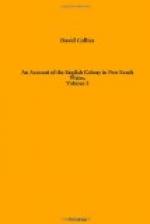This islet must at times be visited by natives; for they found three spears, and near them was hidden a small shield, of the same form and substance as that seen in Pumice-Stone river. The spears were of solid wood, of twelve feet in length, and could not have been used with a throwing-stick. One of them was barbed with a small piece of some animal’s bone.
From the trending of the shores of this harbour, it was divided into two bays, an upper and a lower bay; the former of which was the smallest, and, in comparison with the latter, resembled the cod to a seine. The shore on the east side of this bay (the upper) was high, and bounded by white, steep cliffs; whence Mr. Flinders was induced to hope that a deep channel might be found there, being unwilling to believe that there was not a good passage even to the head of a sheet of water of six or seven miles square, and into which most probably one or more streams of water emptied themselves.
With the intention of attempting the eastern passage into this upper bay, he returned on board from his visit to the islet (which he named Curlew-Islet, and which is in the latitude of 25 degrees 17 minutes S) and got the sloop under weigh; but was obliged to give up the idea, on finding the shoal water so extensive as to make it probable that it joined a line of breakers; and, the sun being near the horizon, to get clear of the shoal water before dark became a principal concern, and together induced him to shape a course for a sloping hummock on the west side of the bay.
The soundings deepened gradually to six fathoms; but, shoaling again to three and even two fathoms, Mr Flinders suspected that the flood tide might have set the vessel to the southward toward the shore; this, however, did not appear to have happened; for at daylight the following morning her situation was what he supposed it would be, the sloping hummock bearing W 5 degrees N and their distance off shore about two miles, the wind having remained at SW during the whole night.
Keeping along the shore until nine o’clock, the water shoaled to nine feet, and obliged them to haul off to the NE. Being now to the northward of where Captain Cook had laid down the coast line, and the land being visible at W 10 degrees N from the deck, and as far as NW from the mast head, he judged it unnecessary to pursue the research any longer, under the supposition of there being a double bay, and therefore continued his course for the extreme of Break Sea Spit, the sloping hummock bearing S 9 degrees E at the time of altering the course.
The coast round Hervey’s Bay was, in general, low near the shore, and on the west side the low land extended to some distance inwards. On that side the land wore a different appearance from that of Sandy Cape, there being few marks of sand, and the shore was mostly rocky. Advancing toward the head, the beaches presented themselves, and continued with little interruption into the upper bay. A large




